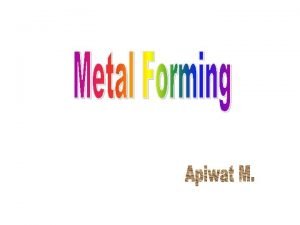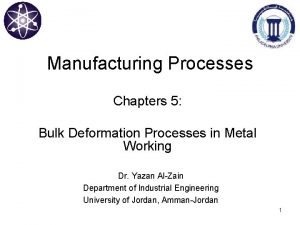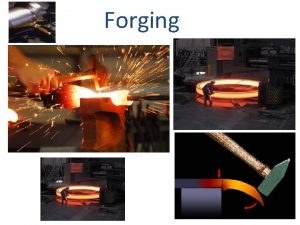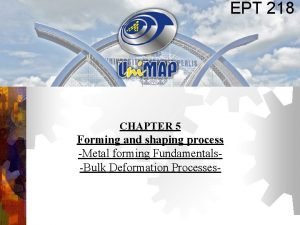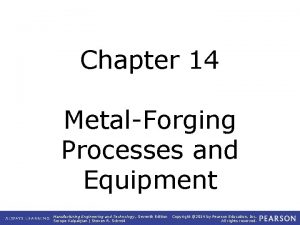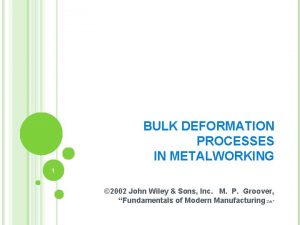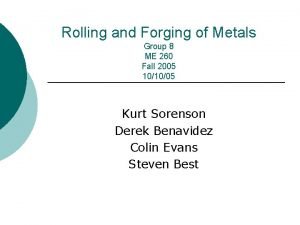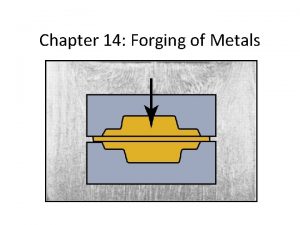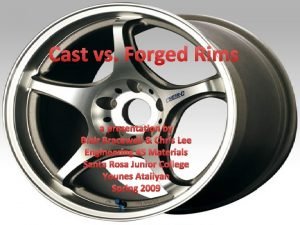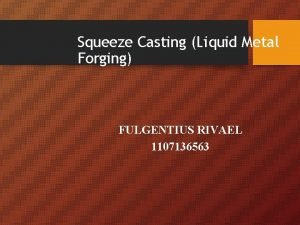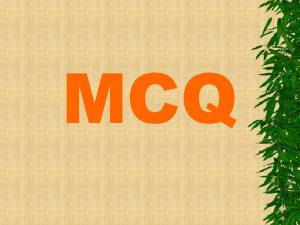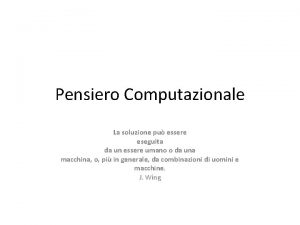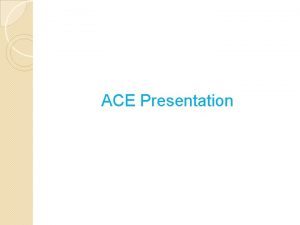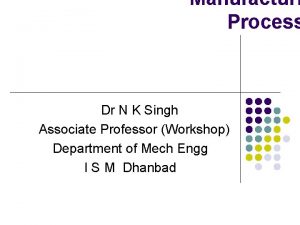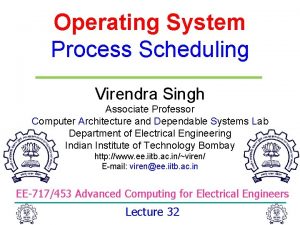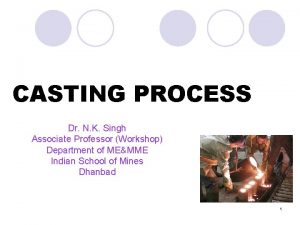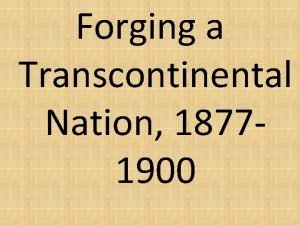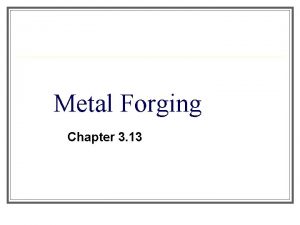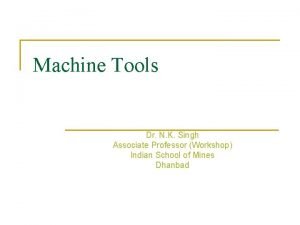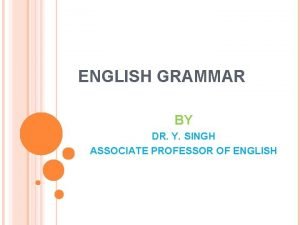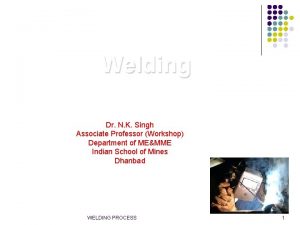Forging Process Dr N K Singh Associate Professor















































































- Slides: 79

Forging Process Dr. N. K. Singh Associate Professor (Workshop) Department of ME&MME Indian School of Mines Dhanbad


Deformation Process Permanent (plastic) deformation of a material under tension, compression, shear or a combination of loads. Types of Deformation Bulk flow in (3) dimensions Simple shearing of material Compound to simple bending Combination of above

Deformation Process Stresses used to produce change Tension Compression Shear Combination in multiple axis (2) Classifications Bulk = Significant change in surface area, thickness and cross section reduced, and overall geometry changed. Sheet = Some deforming of material, but initial material thickness remains the same

Definition of HW vs. CW HW is performed above the recrystallization temp of the material and CW is done below the recryllization temp of the material. Recystallization Temp- “The approximate minimum temp at which complete recyrallization of a cold worked metal occurs within a specified time. ” -Heat Treaters’s Guide, American Society for Metals

Hot Working When HW a metal is in a plastic state and is easily formed. The forces required to deform the metal are less than CW. Some mechanical properties of the metal are improved due to process characteristics. At elevated temperatures, metal microstructures are rebuilding continually through the re-crystallization process which allows for much higher deformation.

Advantages to HW Porosity in metal is largely eliminated Impurities (inclusions) are broken up and distributed through the metal Course grains are refined Due to grain refinement, the physical properties are generally improved Ductility and resistance to impact are improved Strength is increased Amount of energy necessary to change the shape of the raw material in a plastic state is far less than if the material was “cold. ” Economical compared to CW

Forging The plastic deformation of metals, typically at elevated temperatures, using compressive forces exerted through a die to conform the metal to a desired shape. Process advantages: Closing of voids in the metal Reduced machining time Improve the physical properties of the starting metal

Forging Methods Open-Die Drop Hammer - heated metal is placed between dies—a force is delivered with a steam hammer. Accuracy is not good Complicated shapes are difficult to produce


Black smith operation on a red hot metallic workpiece

Tools of the Smithy Shop Most of the blacksmiths' work is done with hand tools. 1. 2. 3. The most commonly used tools are Anvil Hammer. Tong

Steel anvils 13

Anvil To the uninitiated all anvils look alike. Just a big lump of iron with pointed ends. In fact they are a deceivingly sophisticated tool that are made in many styles, materials and sizes. * The best anvils are made of selectively hardened tool steel with a well balanced attractive shape and various useful working surfaces. It has taken centuries to develop the shapes of anvils and similar to the violin some anvil styles were perfected long ago and will probably never change. 14

Different parts of the Anvil 15

Students working in a smithy shop 16

Types of Anvils There are five basic types of anvil, forging, shoeing (farrier's), sheet metal, bench jewelers. 17

Types of Anvils These types are different in both size and style. As with most tools there is a lot of overlap in application. A forging anvil or general shop anvil can also be used for making horse shoes and light forging can be done on a farrier's anvil. A heavy sheet metal stake can be used for light forging and bench work. 18

Types of Anvils Small bench work anvils can be used for jewelry but are clumsy for delicate work. However it is impossible to forge anything larger than fine wire on a little 5 oz. (150 g) jewelers anvil and difficult to use a large 200 pound (90 kg) forging anvil for jewelry work. Each task is best performed using the proper size tool. 19

Types of Anvils The size of the anvil should be proportional to the work and the hammer used to perform that work. For forging an average hand hammer to anvil ratio of about 50: 1 is normal. Example, a heavy 4 pound (1800 g) hammer and a 200 pound (90 kg) anvil are a good match. ………………………………. . 20

Forging anvil 21

Forging anvils These are also known as blacksmiths or general shop anvils. These range in weight from about 75 pounds to 500 pounds. They differ from farrier's anvils in that there is more mass in the body directly under the face and less distributed in the horn and heel. 22

Forging anvils Due to the prevalence of horse drawn transportation in the early part of the 20 th century most popular anvils were a combination of farrier's and forging anvil. Today the Peddinghaus, Vaughans, Euro and Nimba are typical forging anvils. These are designed for heavy forging and have all the standard dimensions 23

Farriers anvils 24

Farriers anvils may look like any other anvil to the neophyte but they are a highly specialized type of anvil. Modern farriers anvils put a high proportion of the mass in the horn and often have just enough in the heel to balance the anvil. The base has negligible mass. Because the majority of modern farriers travel to the horse, most farrier's anvils are made in the portability range of 100 to 150 pounds (45 to 70 kg). 25

Farriers anvils Modern farrier's anvils also have special features such as "clip horns" forming toe clips and turning cams for ease of adjusting a shoe. Due to their very narrow waist most farrier's anvils are too springy for general forging work and should be avoided by non-farriers. All the currently available farriers anvils are cast steel or hardened ductile iron. 26

Classification of anvils Type by Weight Range - Min. - Max. Pounds Type Kilos 75 - 500 Forging 35 - 230 50 - 150 Farrier 23 - 70 5 - 100 Stake 2. 3 - 45 5 - 50 Bench 2. 3 - 23 0. 3 - 5 Jewelers 0. 14 - 2. 3 27

Leg Vice – a fixture for smithy operation 28

Stake Anvil 29

Stake Anvils 30

Stake anvil These anvils for heavy use are largely out of style and no longer available. Small stake anvils are available from Peddinghaus and several manufacturers make the types designed for sheet metal and artistic iron work. Modern sheet metal stakes are designed to be supported in a stake plate or bench socket. 31

Stake anvil However, they can be supported in a vice for light work or stump mounted like the old fashioned stake anvils. Stake anvils for sheet metal work are rarely very heavy the largest weighing 15 or 20 pounds. There are dozens of shapes available. 32

Stake anvil The "blowhorn" stake is the most common having a large steep half cone on one side and a long tapered round on the other. A "beakhorn" stake is similar except the long arm is rectangular. There are many others named for their original purpose such as "needle case" and "candle mold". 33

Stake anvil The "blowhorn" was made for making musical brass horns. Then there are others named for their shape such as mushroom, ball, hatchet or grooving stakes. Stake anvils are not suitable forging but can be used for bench and heavier jewelry work. 34

Jeweler's Anvil 35

Jeweler's Anvil These anvils are made in an old style that has not changed for 300 years or more. They have a squarish body and long slender bicks. Some have stakes to embed in a bench and others a large base. 36

Jeweler's Anvil Jewelers anvils are made of forged or cast tool steel and finely finished all over. Weights range from a few ounces to a few pounds. Jewelers anvils were also sold as silversmiths, watch and clockmakers anvils. 37

Bench Anvil 38

Bench Anvil These anvils are small anvils that range in size from 5 to 50 pounds. Generally the only definition of a bench anvil is that it is used on a bench for supporting work to be hammered. Styles vary from the familiar London pattern, European double horned or the classic double horned jewelers anvil with long slender bicks (horns). 39

Bench Anvil They can also simply be a convenient block of steel. English locksmith's bench anvils have a working end of 8 or 10" (200 -250 mm) long and leg that goes to the floor. Many bench anvils have been made of structural steel and rail road rail. 40

Bench Anvil Others are special small anvils made for hardware suppliers. Occasionally a small forging anvil is used for a bench anvil. 41

Quality Ranking of Anvils by Construction Ranks Material 1 Forged Tool Steel 2 Steel Plate on Wrought Body 3 Cast Tool Steel 4 Steel Plate on Cast Iron* 5 Hardened Ductile Iron 6 Chilled Cast Iron 7 Cast Iron (ASO**) * Historical manufacturing method no longer used. ** ASO, Anvil Shaped Object 42

Tongs are used when a piece of metal is too hot or short to go from the forge to the anvil. Tongs come in every shape and size imaginable. The smith selects the pair most suited for the job he's doing.

Flat Jaw Tongs

Different Types of Tongs Open Mouth Tongs Square Mouth Tongs Rivet Tongs Universal Tongs

Different Types of Tongs Pick up or dandy tongs Crucible Lift out tongs Single bow tongs Bolt tongs

Hammers are used by a smith in order to give the required shape to the heated metal piece. Hand operated hammers are generally employed for shaping small and light components.

Different classes of Hammers 1. 2. 3. 4. Ball pein hammer Cross pein hammer Straight pein hammer Sledge hammer

Ball Pein Hammer

Ball Pein Hammer A ball-peen hammer is a type of peening hammer used in metal working. (The spelling ball-pein is usual in the UK. ) It is distinguished from a point-peen hammer or chisel-peen hammer by having a hemispherical peening head. Though the process of peening has become rarer in metal fabrication, the ball-peen hammer remains useful for many tasks such as tapping punches and chisels. The original function of the hammer was to "peen" riveted or welded material so that it will exhibit the same elastic behavior as the surrounding material.

Ball Pein Hammer Specifically, striking the metal imparts a stress at the point of impact which results in strain-hardening of that area. Strain hardening raises the elastic limit of a material into the plastic range without affecting its ultimate strength. A strain-hardened material will not deform under the same low stresses as a non-hardened material. Most metals can be "worked" by such methods until they lose all of their ductile characteristics and become strong but brittle.

Ball Pein Hammer The ball-peen hammer is also used to expand shape the free end of copper roves, light rivets and similar, "setting" the rivet in place to complete the joint. Peening is also the method by which steel drums are formed and tuned. A ball-peen hammer is also known as an engineer's hammer or a machinist hammer and may be graded by the weight of the head. It is the mechanics hammer of choice when making gaskets or driving drift pins.

Cross pein hammer The pein is across i. e. at right angle to the axis of the handle of the hammer. Weight of the hammer is 0. 22 to 0. 91 kg. The cross pein hammer is used for bending, stretching and hammering into the inside positions of the component.

Cross pein hammer

Straight pein hammer The pein is straight i. e. parallel to the axis of the handle of the hammers. Weight of the hammers is 0. 11 0. 91 kg. The straight pein hammer is used for stretching the metal.

Sledge Hammer

Sledge Hammer A sledge hammer is heavier than a Smith’s hand hammer described earlier. The weights vary from 3 to 10 kg are used when heavy blows are required to be imparted to the jobs. The striking surface of the sledge hammer is made slightly convex and smooth. The aim is that the workpiece metal is not spoiled by the edges of the hammer if they are sharp.

Operations of Smithy Shop Smith forging is done on anvil. It is employed only to shape a small number of light weight forgings. The operations of smith forging are - upsetting or jumping - drawing down - bending

Operations of Smithy Shop - cutting - punching and drifting - fullering - setting down - flatting - swaging - forge welding

Upsetting or Jumping It is an operation to carry out to increase thickness (or diameter ) of a bar and to reduce its length. Generally the increase in thickness is local as in the case of forming a bolt head. Only that portion of the bar which is to be upset is heated locally. The whole bar is heated and except for the portion to be upset, the rest is quenched in water so that upset will form only on the hot portion of the bar.

Drawing down is to reduce thickness of a bar and to increase its length. It is may be carried out by working the metal over the horn of the anvil then by hammering it on the anvil face. The rounded horn of the anvil acts as a blunt edge which forces the hot metal to flow lengthwise when struck by the hammer. For drawing down very heavy work fuller may be used.

Bending is a very common forging operation. The simplest method of bending a piece of metal in hand forging to support it on the anvil and to strike its free end with a hammer. When bent the metal of the workpiece tins out round bend causing weakness. This can be overcome by upsetting prior to bending.

Hot Cutting A hot set (chisel) is used for cutting heated metal bars in a smithy shop. The hot set does not required to be hardened or tempered. Hot sets are manufactured from the tough variety of steel in order that they may cut through relatively soft red hot metals with ease.

Punching & Drifting For punching a hole the metal workpiece must be at near welding heat. The punch is driven part way through the workpiece with the hammer blows. The work is then turned over and the hole is completed from the other side. The above mentioned part is adopted for a thicker workpiece.

Fullering reduces the thickness of a heated metal workpiece having a thicker section. The bottom fuller is held in the hardie hole of the anvil and the workpiece is rapidly reduced in thickness in moving it between the top and the bottom fullers while striking the top fuller with the sledge hammer. Fullers are also used for making shoulders or grooves across the metal.

Flatting and setting down Fullering leaves a corrugated surface on the job. Even after a job has been forged into shape with a hammer, the marks of the hammer remain on the upper surface of the job. To remove the hammer marks or corrugations and in order to obtain a smooth surface on the job a flatter or a set hammer may be used.

Swage Blocks

Swaging is done to reduce and finish work to desired size and shape usually either round or hexagonal. For small jobs top and bottom swage pair is employed where as for large work, the swage block can be used.

Bronze Swage Block

Different tools used in smithy shop S 39 Hot Set Rodded, S 40 Cold Set Rodded, S 47 Round Punch, Rodded, S 47 Round Punch Handled, S 48 Square Punch Rodded

Different tools used in smithy shop S 32 Bottom Swage, S 34 Bottom Fuller, S 37 Hardie, S 37 A Shoecropper

Forge Welding Wrought iron and low carbon steel can be satisfactorily forge welded. Forge welding can be carried out with metal thickness upto above 30 mm.

Hot set A hot set is a chisel used for cutting hot metal pieces during the forging process. A hot set is made up of hard steel but is of larger diameter and of a shorter length than the cold chisel.

Hardie A hardie is chisel. It has a square shank and is mounted in the hardie hole of the anvil. To cut a bar the hardie and cold set are used together.

Cold cutting and hot cutting Hardies

Temperature of Different colors in Smithy Sl. No. Colors Temperature 1 Dark red 7000 C 2 Cherry red 7600 C 3 Orange red 9800 C 4 Yellow red 10900 C 5 White red 13000 C

Safety Rules for Smithy shop One should not touch the job with bare hands unless he is that is cold. One has to wear tight cloth and shoes. One has to hold the job tightly and keep it flat on the face of the anvil.

Safety Rules for Smithy shop One has to examine the hammer to make sure that it is in working order. Job should be tightly held in vice before starting work.

Hearth
 Promotion from assistant to associate professor
Promotion from assistant to associate professor Raj birk
Raj birk Bulk deformation processes
Bulk deformation processes Flashless forging process
Flashless forging process Types of forging
Types of forging Flashless forging process
Flashless forging process Flashless forging process
Flashless forging process Flashless forging process
Flashless forging process Forging process ppt
Forging process ppt Forging defects, with images pdf
Forging defects, with images pdf Teknik pembentukan
Teknik pembentukan Flashless forging adalah
Flashless forging adalah Forging force
Forging force Forging vs casting pros and cons
Forging vs casting pros and cons Chapter 7 lesson 2 forging a new constitution
Chapter 7 lesson 2 forging a new constitution Power generation forging
Power generation forging Forging a new deal section 1 answers
Forging a new deal section 1 answers Chapter 6 the new republic
Chapter 6 the new republic Upset forging die design factory
Upset forging die design factory Pengertian squeeze casting
Pengertian squeeze casting Sticking friction in forging
Sticking friction in forging Mcq on sheet metal forming
Mcq on sheet metal forming Hubbing forging
Hubbing forging Basketsess
Basketsess Forging adalah
Forging adalah Forging
Forging Is bcs worth it
Is bcs worth it Tecniche associate al pensiero computazionale:
Tecniche associate al pensiero computazionale: The pyramid at chichen itza is most closely associate with
The pyramid at chichen itza is most closely associate with Lonestar nursing application deadline
Lonestar nursing application deadline Incose certification
Incose certification What is the disadvantage of direct mapping
What is the disadvantage of direct mapping Cern project associate
Cern project associate Associate degree pie
Associate degree pie Associated consulting engineers
Associated consulting engineers Jeannie watkins
Jeannie watkins Rcog cpd
Rcog cpd Tio collegegeld
Tio collegegeld Associate director meaning
Associate director meaning Harper college
Harper college Iter project associate
Iter project associate Aad program
Aad program Harbor city college nursing
Harbor city college nursing It involves scrutinizing
It involves scrutinizing Delta chi associate member pin
Delta chi associate member pin Associate degree rmit
Associate degree rmit Adobe spark certificate
Adobe spark certificate Cincinnati state associate degrees
Cincinnati state associate degrees Safety associate
Safety associate Associate warden
Associate warden Sales profit chain
Sales profit chain Imeche associate membership
Imeche associate membership To associate
To associate Hea associate fellowship
Hea associate fellowship Associate consultant in capgemini
Associate consultant in capgemini Associate program
Associate program Associate consultant in capgemini
Associate consultant in capgemini Mhp associate partner gehalt
Mhp associate partner gehalt Ruckus certified partner
Ruckus certified partner Memorandum of association defines
Memorandum of association defines Marine corps league red blazer
Marine corps league red blazer Cipd experience assessment
Cipd experience assessment Name something you associate with superman
Name something you associate with superman Child development teacher permit
Child development teacher permit Sandeep singh jolly berlin
Sandeep singh jolly berlin Yatindra nath singh
Yatindra nath singh Singh song
Singh song Sexual harrasment prevention training
Sexual harrasment prevention training Dr ajit singh
Dr ajit singh Iqbal dhaliwal
Iqbal dhaliwal Presentation on linux operating system
Presentation on linux operating system Ggssc law
Ggssc law Navpreet singh iit kanpur
Navpreet singh iit kanpur Motivational interviewing stages of change
Motivational interviewing stages of change Rajanvir singh kapur ias
Rajanvir singh kapur ias Usha mehta savitribai phule
Usha mehta savitribai phule Guru gobind singh study circle books
Guru gobind singh study circle books Mannu singh vs umadat pandey
Mannu singh vs umadat pandey Muninder singh
Muninder singh Parkaranjot singh
Parkaranjot singh


